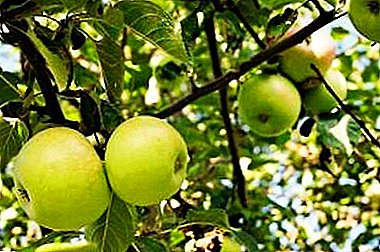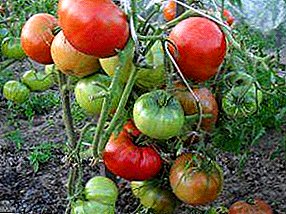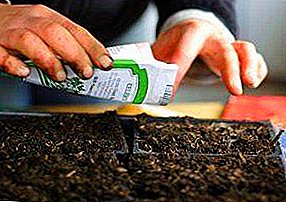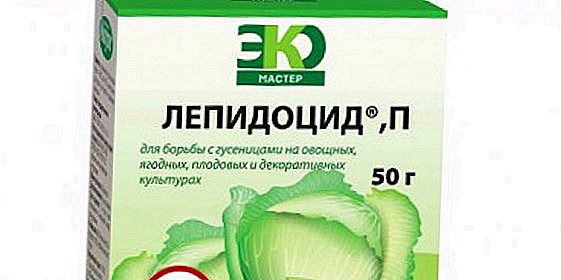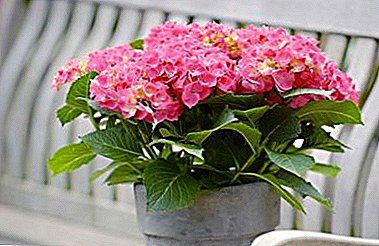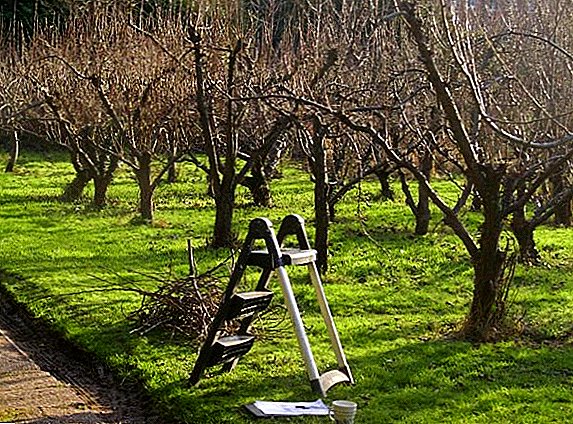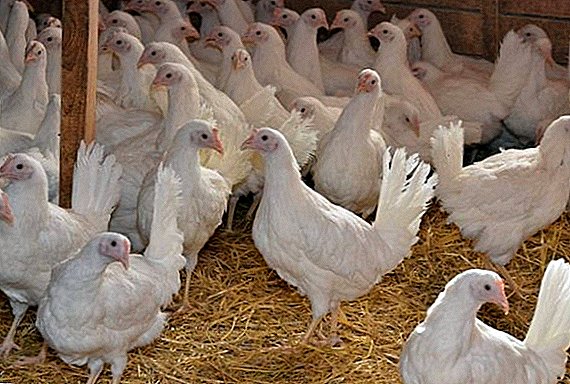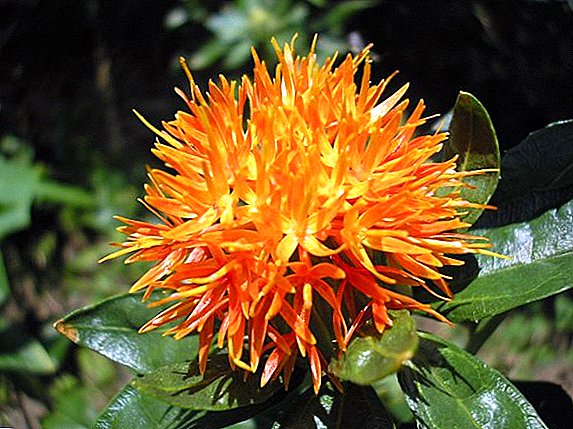 Many useful plants, successfully grown in certain regions and benefiting in many industries, remain unknown and unclaimed by the majority of the population.
Many useful plants, successfully grown in certain regions and benefiting in many industries, remain unknown and unclaimed by the majority of the population.
This article will discuss safflower, discuss What is this plant, what is its benefits and features.
Safflower: description and biological features
Safflower is a plant of the Asteraceae or Aster family, most often an annual plant, safflower or wild saffron is grown in culture, as it is called. Safflower grows up to one and a half meters, the plant has a straight, branched, glossy stem. Leaves oblong, arranged alternately, on the edge of the leaf plate - spikes. The flowers of the plant are saturated orange or red, tubular, after flowering form the fruit-seeds of white.
 Safflower is an oilseed crop, seed oil is not inferior to sunflower oil. Oil of the first grade is used in the food industry, the second grades are used for the manufacture of industrial oils, drying oil, varnishes. In the food industry, the plant is also used as a natural dye safe for the human body, as well as in the manufacture of margarine and confectionery; the dye is used in the textile industry, for dyeing fabrics, making carpets.
Safflower is an oilseed crop, seed oil is not inferior to sunflower oil. Oil of the first grade is used in the food industry, the second grades are used for the manufacture of industrial oils, drying oil, varnishes. In the food industry, the plant is also used as a natural dye safe for the human body, as well as in the manufacture of margarine and confectionery; the dye is used in the textile industry, for dyeing fabrics, making carpets.
Safflower is used in medicine and cosmetology. Virtually all parts of the plant are useful. Safflower is also a honey plant. Honey of this plant is a mini first aid kit. It consists of vitamins B, E, C, A, PP; enzymes and organic acids; proteins and dextrins. The composition of honey from safflower includes almost all the macro-and microelements necessary for the vital activity of the human body.
With such a mass of beneficial properties and qualities, safflower is absolutely uncaprizable in cultivation. Seed germination of the plant is possible at two degrees of heat, young shoots withstand frost up to six degrees, that is, the planting of the plant is carried out in early spring and autumn.
Safflower varieties
In the culture of few varieties suitable for growing in the middle lane. Consider the most suitable of them.
 The most popular variety is "Sunny" - the plant tolerates a dry period well. The vegetation period is 127 days. It grows up to 85 cm. Flowers with a diameter of up to three centimeters contain a large number of seeds, the total yield per hectare is one and a half tons. The rate of oil content in the seed - 34%. The variety is grown in many countries, including Kazakhstan, Russia and Ukraine.
The most popular variety is "Sunny" - the plant tolerates a dry period well. The vegetation period is 127 days. It grows up to 85 cm. Flowers with a diameter of up to three centimeters contain a large number of seeds, the total yield per hectare is one and a half tons. The rate of oil content in the seed - 34%. The variety is grown in many countries, including Kazakhstan, Russia and Ukraine.
Safflower varieties "Ahram" differs abbreviated vegetation period - from 90 to 120 days. The plant is low compared to the "Sunny" safflower - 60 cm, branched, leafy, with many flowers (up to sixteen baskets on one inflorescence). The plant is late ripening, the yield of the variety is 15 centners per hectare. The oil content in the seed is 35%, the variety is considered the best for processing into oil, from one hectare receive up to 300 kg of oil.
Variety "Beauty Stupinskaya" - a plant with an erect branched stem without edge; with a strong taproot growing up to 20 cm deep, then the rod becomes thinner and under favorable conditions (in the southern regions) can reach a depth of two meters. The leaves of this variety are oval-elliptical in shape, with a serrated edge and weak spines. The vegetative period of a plant is from 105 to 130 days. One bush can carry up to twenty baskets of inflorescences with a diameter of up to 3.5 cm. The petals are tubular, yellow or orange in color. Fruits: white seeds with a dense shell, seed weight up to 51 grams. It is characteristic that the seeds do not crumble when ripe.
Place in the rotation
 Cultivation technology for safflower precursors are tilled crops, winter and spring crops, rape, corn, flax. At observance of such a crop rotation the soil forms large stocks of moisture, its phytosanitary background improves.
Cultivation technology for safflower precursors are tilled crops, winter and spring crops, rape, corn, flax. At observance of such a crop rotation the soil forms large stocks of moisture, its phytosanitary background improves.
Important! Do not plant safflower after sunflower, sugar beet and fodder beet, sorghum. These plants pull out almost all the moisture from the soil.
It is not necessary to grow a crop in one place for several years in a row; a return to the previous landing site is possible at least four years later. Safflower is an ideal predecessor for grain crops, spring and winter barley and wheat (in good autumn weather conditions).
The best order of crop rotation will be the placement of safflower of the next-to-last sowing crop, for example, steam - winter wheat - safflower - barley; or steam - winter wheat - chickpea - spring wheat - safflower - barley.
Tillage
 Greatly facilitates the cultivation of safflower undemanding to the composition of the soil. The best for him are chernozems and chestnut lands, loose sandy loams or loams, while he is not afraid of saline and poor lands.
Greatly facilitates the cultivation of safflower undemanding to the composition of the soil. The best for him are chernozems and chestnut lands, loose sandy loams or loams, while he is not afraid of saline and poor lands.
For safflower, deep tillage is important, the best indicators of the harvest are formed when sowing in a deep plowed field. Cultivate arable and subsurface soil layers. Despite the fact that the safflower is not afraid of weeds, before sowing a deep cleaning of weeds is carried out. When sown after cereals, it is good for safflower if after harvesting the predecessor, straw and chaff scattered in a thin layer are left on the field.
Sowing methods and seeding rates
Sowing safflower can be carried out simultaneously with grain spring plants, because the seeds can germinate at low temperatures. In late sowing, the moisture level in the upper soil layer may not be sufficient for good germination.
In order to protect against disease and increase yield, seeds are pickled in preparations. "Premis" or "Cardon", adding stimulants to root development.
 Sowing is carried out at a depth of six to eight centimeters, between rows leave up to 60 cm. The seeding rate of safflower seeds is 30-40 kg / ha. The rate is determined by the conditions of soil moisture, under favorable conditions, sowing is carried out by the maximum value, with worse conditions - the rate is reduced.
Sowing is carried out at a depth of six to eight centimeters, between rows leave up to 60 cm. The seeding rate of safflower seeds is 30-40 kg / ha. The rate is determined by the conditions of soil moisture, under favorable conditions, sowing is carried out by the maximum value, with worse conditions - the rate is reduced.
Did you know? Back in 1061, the Chinese were treating heart and blood disease with safflower. In ancient times, safflower was also used to interrupt unwanted pregnancies, so that women who are expecting a baby should better give up the product.
Safflower Care
Care for safflower is mainly in the care of the soil: loosening the top layer, thinning and weeding from weeds.
Attention! Clogging safflower with safflower will increase yields by seventy percent.
Safflower can do without watering for a long time thanks to the universal root system, growing far inland. Watering is carried out as needed, mainly with a long absence of precipitation and complete drying of the upper layers of the soil.
 When sowing crops on fertile soils, you should not worry about fertilizing; if the soils are poor, it is better to fertilize them with organic or mineral fertilizers, nitrogen-phosphorus-potassium fertilizers. You can make before the flowering period, experienced growers advise to fertilize the soil during processing before sowing.
When sowing crops on fertile soils, you should not worry about fertilizing; if the soils are poor, it is better to fertilize them with organic or mineral fertilizers, nitrogen-phosphorus-potassium fertilizers. You can make before the flowering period, experienced growers advise to fertilize the soil during processing before sowing.
Growing safflower from seeds is easy, care is not burdensome. The main thing is to carry out sowing rolling, harrowing until the first shoots appear and when two or three strong leaves appear on the shoots, crust is destroyed on the soil surface. Plant care is completed during the formation of buds.
Protection against diseases and pests of safflower
Safflower can be affected by the following diseases: fusarium, rust, septoria and broomrape. The most dangerous disease for safflower that can destroy crops is rust. The disease is fungal in nature, affects the shoots and foliage roundish formations - brown pustules. With the defeat of diseases, the crops are treated by chemical means: Altazol, Alto Super, Acanto Plus, Alpari, Atlas.
Pests that attack crops on plants are safflower fly, weevil, aphid and ognevka. Insects and their larvae are also dangerous. Adults gnaw stalks and foliage, lay eggs, from which the larvae hatch, sucking the plant juice and not only. Safflower fly lays offspring in safflower buds, the larvae appearing afterwards eat the seeds. For the destruction of pests using insecticides: "Konfidor-Maxi", "Kruiser", "Puma Super-100". As a preventive for safflower, before planting, seeds are treated with various dressings.
Interesting! During the excavation of Egyptian tombs, archaeologists found that the ancient Egyptians dyed with mummification dressings with paint made from safflower petals. According to many written testimonies, the beauties of Arab countries used pounded petals as blush and lipstick.
Harvest
 Harvesting safflower does not cause difficulties, since the seeds do not crumble when ripe. They can crumble only in case of untimely harvesting from striking the blade of the header on the stalks. Safflower harvesting begins at full ripeness, which is determined by the yellow baskets and yellowed stems. On the fields, harvesting is carried out by combines so that the stems of the plants are not wound on the drum, the cutting height is increased. Seed moisture when harvesting should be about 12%. After harvesting, the seeds are cleaned from the chaff and dried.
Harvesting safflower does not cause difficulties, since the seeds do not crumble when ripe. They can crumble only in case of untimely harvesting from striking the blade of the header on the stalks. Safflower harvesting begins at full ripeness, which is determined by the yellow baskets and yellowed stems. On the fields, harvesting is carried out by combines so that the stems of the plants are not wound on the drum, the cutting height is increased. Seed moisture when harvesting should be about 12%. After harvesting, the seeds are cleaned from the chaff and dried.
Safflower as a useful culture deserves attention in the agricultural industry. In addition to all of the listed areas of use (medicine, textile and food industry, paint and varnish production) safflower is also grown as a fodder crop, as a green silo for large and small livestock.


